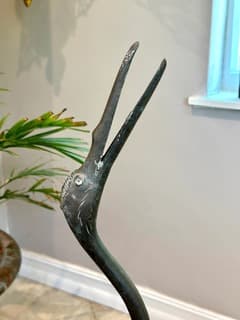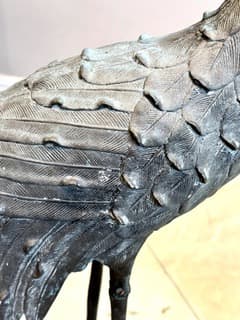
Curated with aloha by
Ted Mooney, P.E. RET

The authoritative public forum
for Metal Finishing 1989-2025

-----
Bronze disease or just calcium deposits?
Q. I am interested in purchasing a Japanese bronze sculpture for my garden They are quite pricey and just found this taisho era ( 1912-1926) piece which is within my budget However it seems there are some whitish spots and am worried if it is bronze disease secondary to chlorides coming in contact with bronze, or whether it is calcium deposit. Of course I cannot trust if the seller will agree to try removing with vinegar.


Your opinion is highly appreciated.
c johnstoncollector - Maryland
^
A. Hi.
I've never heard of that term 'bronze disease' to my recollection -- but I am not in the art world nor the bronze statuary world. Still, I can't envision how it could be calcium deposits though.
I would say that it is corrosion of the bronze, but also say that corrosion products are usually voluminous and the actual loss of bronze up to this point might be so minimal as to be nearly imperceptible.
If it was me, I'd ...
• wipe it down with vinegar
⇦in bulk on
eBay
or
Amazon [affil links] or another mild acid to dissolve the white corrosion,
• neutralize that with baking soda [in bulk on
eBay
or
Amazon [affil links]
, and rinse it well,
•wax it [Renaissance Wax
⇦ this on
eBay
or
Amazon [affil links]
], and keep it indoors.
If it must go in your garden though, perhaps after cleaning it you can spray it with several light coats of Incralac
⇦ this on
eBay or
Amazon [affil links]
.
Luck & Regards,

Ted Mooney, P.E. RET
Striving to live Aloha
finishing.com - Pine Beach, New Jersey
![]() THANK YOU FOR YOUR RESPONSE.
THANK YOU FOR YOUR RESPONSE.
THIS IS AN ANTIQUE TAISHO ( 1912-1926) BRONZE CRANE WHICH IS LIFE SIZE., 52" H. THE JAPANESE CRANE IS ONE OF THE LARGEST BIRSD IN EXISTENCE.
Typically bronze oxidizes only superficially; once a copper oxide (eventually becoming copper carbonate) layer is formed, the underlying metal is protected from further corrosion. This is from an article regarding bronze.
However if the preparation of the bronze is not as well as it should be, moisture can penetrate and cause oxidation.
I do not know if this was placed outdoors and if so, perhaps it can be calcium deposit. If I win the bronze, I will try and clean it per your suggestion of acid, i.e., vinegar. It is intended for outdoor use and so, will follow your instruction of coating although I have never coated any of my outdoor bronzes.
collector - Maryland
July 23, 2023
A. You're certainly welcome.
Although you say that you have never coated bronze, and I said that I have no experience with artwork or bronze statuary, a sage poster noted on this site that life is too short to waste it agonizing over the best way to paint a birdhouse.
So, as long as you consider this piece of yard art something akin to that proverbial birdhouse, it's all good! But if, in mentioning its sculptor who died a hundred years ago, you consider it a precious antique, no one should be practicing on it, but instead referring its restoration & preservation to a metals conservator. Please take a look at https://cool.culturalheritage.org
Luck & Regards,

Ted Mooney, P.E. RET
Striving to live Aloha
finishing.com - Pine Beach, New Jersey
Q, A, or Comment on THIS thread -or- Start a NEW Thread